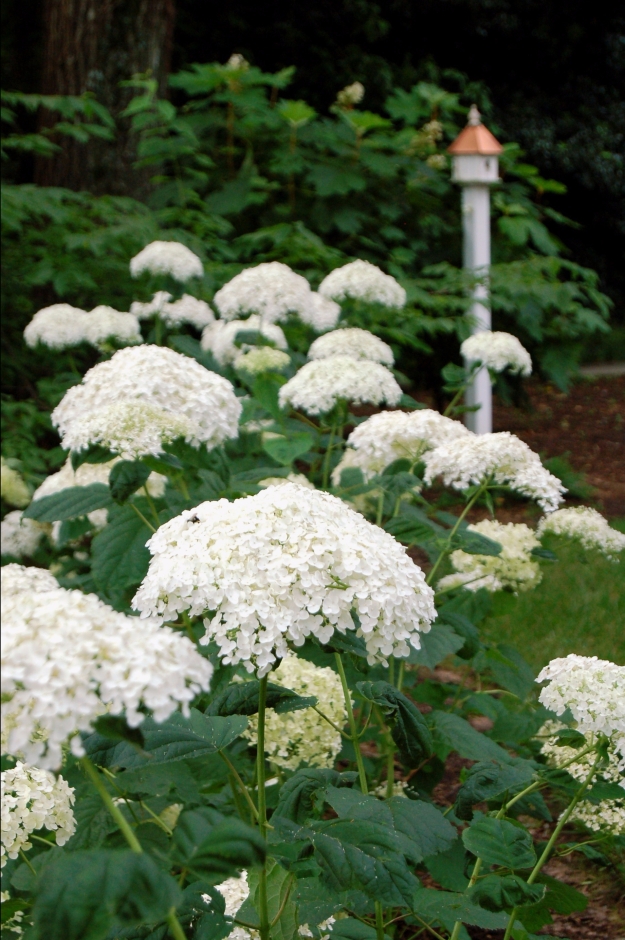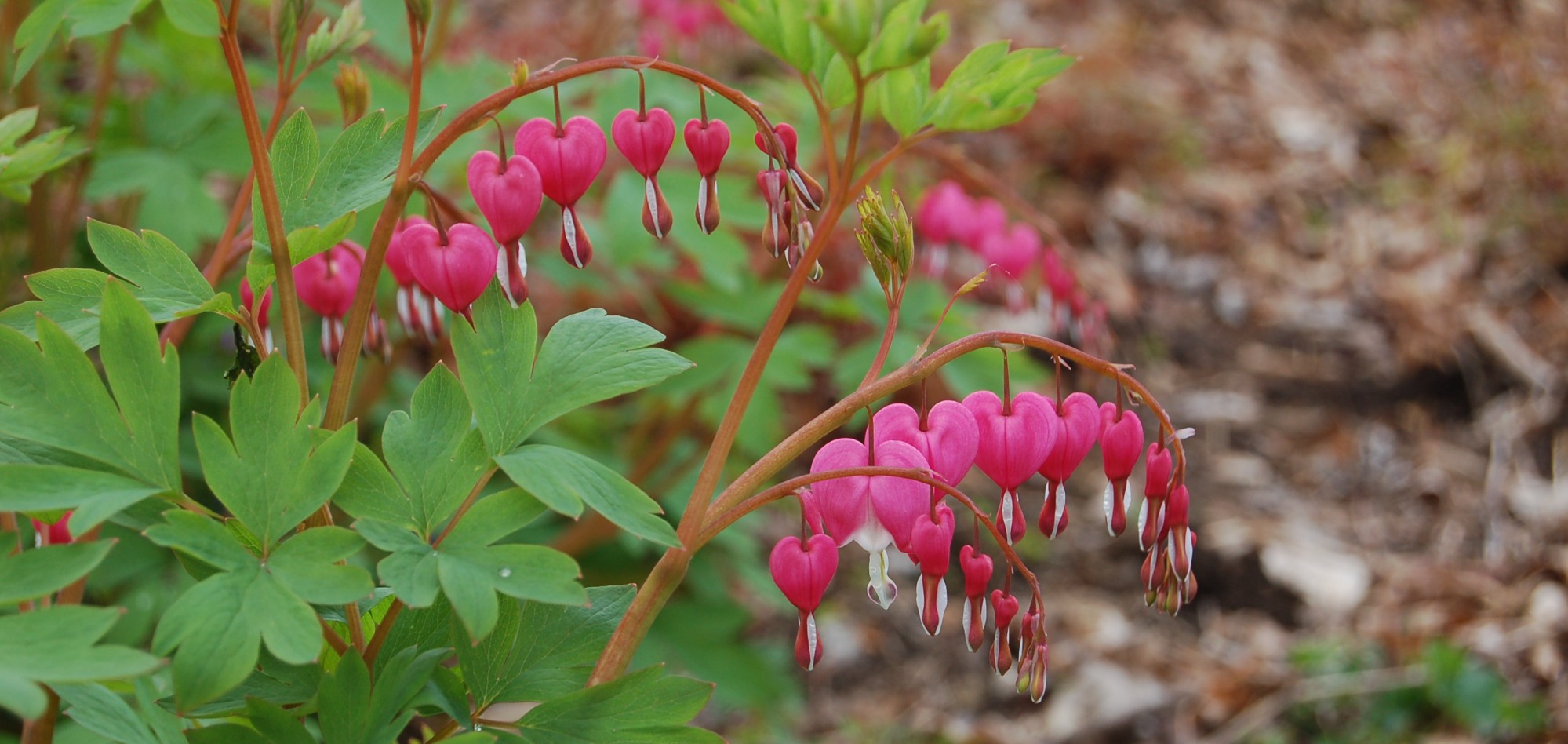When I moved to this shady neighborhood with towering hardwood trees nearly seven years ago, I was happy to find several species of hydrangeas growing in the garden. Since then, I’ve added even more of these beautiful and easy-to-grow shrubs.
My favorite hydrangea was not planted here, however, it grows wild. Hydrangea radiata, though limited in its native range to the southern Appalachian region, is common in the Upstate and I often see it on my wildflower hikes. In the garden here, it grows on a moist, north-facing slope above the Reedy River.

Hydrangea radiata, commonly called silverleaf.
Called silverleaf by those who prefer common names, this hydrangea has striking foliage as well as pretty flowers. While the upper surface of the leaf is green, the underside is bright white, a tale-tell feature easily seen when ruffled by wind.

Hydrangea foliage (top row, left to right): a small unidentified cultivar with pale pink booms, H. radiata, and H. arborescens ‘Incrediball’; and (bottom row, left to right): H. macrophylla and H. quercifolia.
In June, creamy-white blooms open at the tips of the shrub’s spreading branches. Clusters are flat-topped, with larger, sterile flowers surrounding a center of fertile flowers that produce pollen and seeds. One of the nicest things about this hydrangea is that it attracts a wide variety of pollinators.

A very bee-friendly shrub.
In early spring 2012, I added a (then) new selection of hydrangea to the garden that also blooms in June. Named Incrediball, this Hydrangea arborescens, commonly known as smooth hydrangea, is touted as an improvement over its popular parent, Annabelle, offering thicker, sturdier stems that prevent flopping after rain.

Incrediball hydrangea (H. arborescens)
Like others of its species, Incrediball blooms on new wood, so even when killed to the ground during a hard winter, new branches produce summer flowers. It’s also said to be more floriferous than Annabelle, with up to four times more flowers.
This selection, with its bold white blooms that fade to parchment and persist throughout the winter, has become a great favorite. Sadly, it’s also much-loved by voles, but that’s another story.
Linking to Garden Bloggers Bloom Day at May Dreams Gardens.

Beautiful hydrangeas. I have two that are trying very hard to grow in pots, as they do not like our soil here or the warm winters.
Auto–I’ve never tried them in pots, but assume they would thrive with plenty of moisture.
Hi Marian, I was glad to see the hydrangea Radiata. I think that is one in my garden that I have not identified. However, mine is not blooming!! All the others have either bloomed or are blooming now except for this one. Hope all is well with you. We are going to the Brandywine Valley next week. I have tried to contact Hedgeleigh Spring but have not been successful. I looked into the other gardens you are going to in the fall, too. The trip sounds great!!! as ever, Carolyn
>
Carolyn–Hope you have a grand time, it’s the perfect month for visiting Longwood and Chanticleer, two of my favorites. Enjoy!
Voles ate my Incredible Hydrangea too! I didn’t know they were known for this despicable behavior although I am not surprised. They can kill any plant if they set their teeth to it. I love your wild hydrangea. I have always wanted to get one going here. Cheers and Happy GBBD.
Lisa–Strangely enough, I have a new group of the wild hydrangeas popping up in an area where trees have fallen and, thus, is getting more sunlight. If you can find someone who has one, they are easy to propagate by ground layering.
Beautiful!
Happy Garden Bloggers’ Bloom Day!
Thanks, Lea!
A very interesting post on Hydrangeas, thank you. We lost all of our during the drought, but I noticed many being re-planted now that we are having regular rain. I love the Incrediball Hydrangea, and I’ve written that on my list to buy and plant for spring.
Gerrie–Yes, hydrangeas like moisture, so no wonder many were lost. We had a drought last year, but thankfully we are in a pattern of afternoon thunderstorms and are still getting adequate rain. Without storms, our summers can be brutal.
That’s a very interesting photo showing the topside/underside of the different leaves. I am sure H. radiata looks great in the wind, especially on your slope. Voles can be such a menace. They are systematically eating their way through a bed of crocuses I have (in spite of the bulbs now being dormant), so I sympathise.
Dweller–Here’s something you can try…place a mousetrap bated with apple and peanut butter over the problem area and cover it with a shoe box. I’ve had some luck with this method.
This has been an exceptionally good year for my hydrangeas…so far.
John–The last hard freeze, after weeks of warm weather, killed the blooms of my old-fashioned H. macrophylla. This is the 3rd time in 7 years, so when I overhaul the front garden this fall, I’m going to replace them with a newer variety that blooms on new wood. All the others are looking good, though.
Hydrangeas make a wonderful contribution to the late summer/autumn garden here. Yours look wonderful.
Brian–Thanks, I love the freshness of white hydrangeas.
Inspiring! I have several Hydrangeas here, too, and they’re always reliable performers. Good dried flowers, too. 🙂
Beth–The H. macrophylla are often victims of a late freeze here, but everyone loves the blue blooms. The dried flowers on Incrediball are especially nice, I think, and provide interest to the winter garden.
I have several ‘Annabelle’ Hydrangeas, and yes they do flop, but I like them anyway. I’m not going to dig up ‘Annabelle’, but if I were planting a new garden I think I would go with ‘Incrediball’.
Jason–Annabelle is a keeper, I agree, she has that something special. If I was planting now, however, I would probably choose ‘Bounty.’ The flowers are smaller than those on Annabelle and Incrediball, but its very floriferous and the stems are super sturdy.
We used ‘Annabelle’ and another lacecap-type of hydrangea for our last-minute wedding planting (the borders around our ceremony were cleared of clary sage the week before so were going to be bare)
We have them away to family after the wedding and they’re just starting to flower for everyone now.
Craig–Great story! And a lovely way to share the joy of a wedding.
The white undersides to the leaves are really striking. The voles have left my hydrangeas alone so far. What do they do.. chew the roots?
Jessica–Yes, they chew the roots. The Incrediball and oakleaf have both suffered.
I love this post and hydrangeas. I thank you for introducing me to Hydrangea radiata. I’d never heard of it before. I might need one for my very hydrangea garden. I’m also fond of the newish cultivar, Quick Fire. It’s a great paniculata. Hugs!~~Dee
Dee–Quick Fire looks like a winner. I’ll put it on my plant list for fall. Thanks!